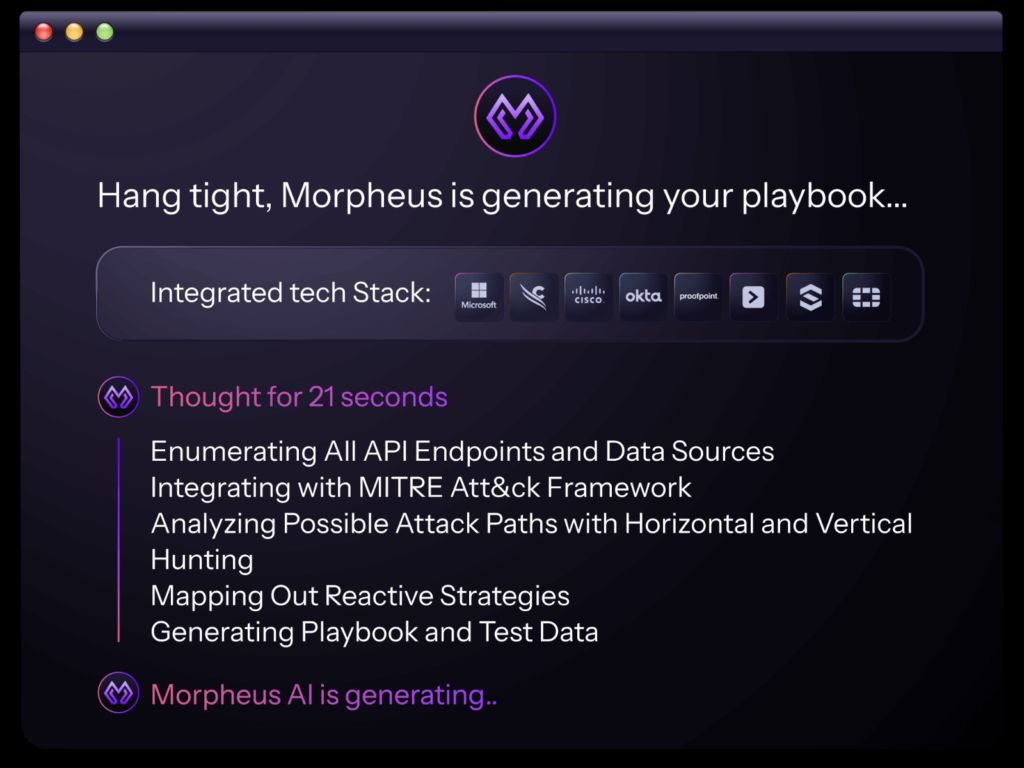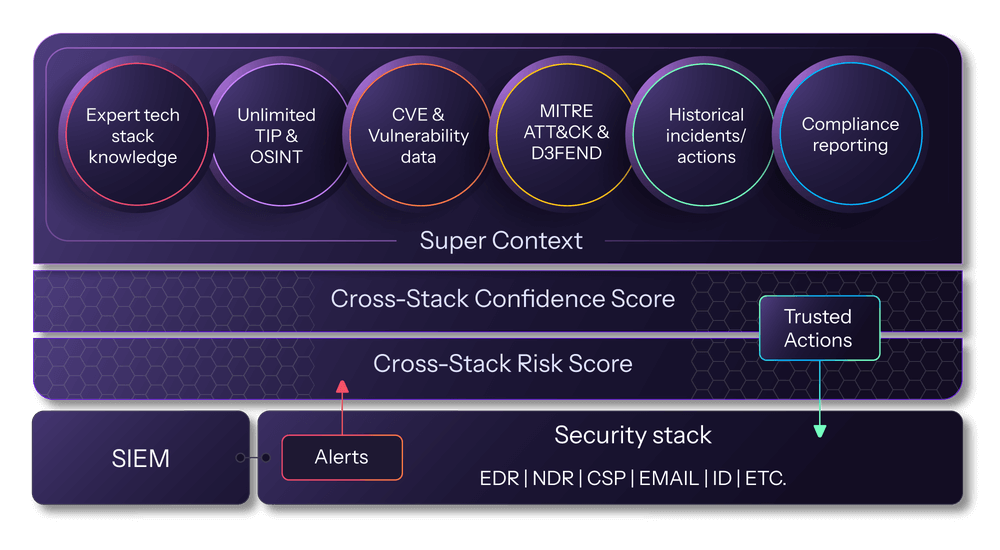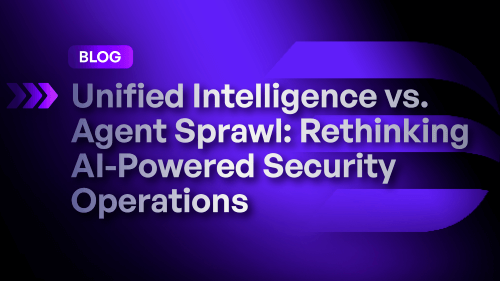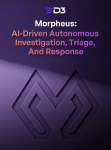Organizations are turning to AI-driven solutions to manage increasing cybersecurity threats and complexity. Two prominent approaches are shaping modern Security Operations Centers (SOCs):
- Unified AI orchestration—exemplified by Morpheus AI by D3 Security, integrating generative AI, vector databases, and workflow automation within a unified platform.
- Agentic AI—which requires building and managing specialized autonomous AI agents for distinct security tasks.
While both paradigms aim for improved automation, they differ fundamentally in operational complexity, scalability, and efficiency. Let’s unpack the critical differences and why the unified approach provides superior efficiency and reduced operational overhead for enterprise SOCs.
The High Cost of Agent Sprawl: Understanding Agentic AI Limitations
What exactly is Agentic AI?
The term is often ambiguous. According to AI expert Simon Willison, “agents” have implied definitions that differ widely. Here, agentic AI means using specialized, autonomous agents—each performing distinct functions with limited oversight.
While this model has proven useful in environments where API integrations are unavailable or impractical (such as unstructured data environments), enterprise cybersecurity usually benefits significantly from existing, robust APIs that render specialized agents unnecessary and overly complex.
Multiple Agents for Multiple Functions
A typical agentic SOC could quickly expand to include many agents.
- Phishing Agent: Identifies suspicious emails and initiates remediation.
- Malware Agent: Integrates with EDR to classify malware and isolate endpoints.
- Vulnerability Scanning Agent: Matches scan results against known CVEs and activates patching workflows.
- User Behavior Agent: Identifies anomalous identity and access patterns.
- Network Traffic Agent: Analyzes connections and alerts on potential malicious activity.
Initially appealing, the agentic approach quickly spirals into complexity, demanding constant attention as security environments expand.
The Steep Price of Specialization
Agentic AI introduces notable operational challenges:
- High Maintenance Burden: Each agent needs independent configuration, constant monitoring, and continuous updates—rapidly multiplying overhead.
- Update Complexity: Changing workflows or threat scenarios often requires recoding or retraining each agent separately.
- Fragmented Visibility: Silos created by separate agents diminish operational clarity.
- Exponential Scalability Challenges: New integrations demand entirely new agents, ballooning complexity.
- Increased Risk of Errors: Multiple autonomous agents operating independently heighten risks of false positives or business disruptions.
- Scattered Audit Trails: Fragmentation complicates forensic investigations and regulatory compliance.
- Prompt Injection Risks: Flexible, open-ended prompts can expose agents to manipulation by malicious actors.
The cumulative impact is significant: operational complexity grows exponentially as agents multiply, straining resources and creating substantial technical debt. Crucially, this complexity is often unnecessary in environments where robust, centralized API integrations already exist.

Morpheus AI: From Alert to Resolution in Minutes, Not Days
Unlike agentic solutions, Morpheus AI provides unified intelligence that fully leverages 800+ integrations through APIs, eliminating the need for agent-based complexity. Morpheus AI simplifies SOC management through a powerful combination of generative AI, vector databases, and automated workflows.
Built-In Generative AI for Rapid, Contextual Analysis
At Morpheus AI’s core is a sophisticated generative AI engine capable of:
- Summarizing Incident Data: Quickly transforming raw alerts into concise summaries.
- Context-Aware Recommendations: Proactively recommending or refining playbooks informed by MITRE ATT&CK, CVE intel, and real-time threat actor data.
- Interactive Conversations: Facilitating analyst Q&A interactions for swift, informed decision-making.
Vector Databases: An Intelligence Powerhouse
Morpheus AI leverages vector embeddings from numerous critical cybersecurity sources—MITRE ATT&CK techniques, CVEs, threat actor profiles, and internal incident records. The benefits include:
- Semantic Matching: Quickly identifies related threats based on semantic similarity, not mere keyword matches.
- Enhanced Contextualization: Provides generative AI with rich, actionable context about threats and vulnerabilities.
- Continuous Intelligence Updates: Vector databases automatically refresh as new threat intel becomes available, eliminating manual updates.
Dynamic Workflow System: Flexible, Centralized, and Efficient
A unified workflow engine within Morpheus AI addresses the pitfalls of agentic sprawl by handling:
- Alert Ingestion: Automates pulling events from EDR, identity solutions, network monitoring tools, and email gateways.
- Real-Time Contextualization: Instantly enriches alerts with current threat intelligence and historical incident data.
- Playbook Automation and Enhancement: Dynamically generates or updates response procedures aligned with evolving threats.
- Adaptive Execution: Executes recommended actions, such as endpoint isolation, blocking malicious domains, or initiating patch workflows with built-in human oversight.
Self-Improving, Self-Adapting Environment
Morpheus continually evolves by learning from analyst feedback, incident outcomes, and evolving cybersecurity stacks. Its unified structure ensures collective improvements:
- Integrated Learning: Every data input refines the entire system, avoiding isolated agent retraining.
- Seamless Stack Integration: Adding or updating tools is effortless—Morpheus AI automatically adapts workflows, maintaining efficiency.

Comparing Morpheus AI with Agentic AI Solutions
| Feature | Morpheus AI (Unified) | Agentic AI |
| Automation Model | Single unified AI-driven framework | Multiple independent agents, increased security risk |
| Maintenance Overhead | Minimal; centralized updates | Significant, complex, error-prone |
| Learning & Adaptation | Collective; entire system evolves together | Fragmented; isolated agent learning |
| Complexity | Centralized, easily managed | High complexity, increased attack surface, frequent “agent sprawl” |
| Threat Intel Integration | Unified vector database (CVE, MITRE ATT&CK, CTI) | Separate integrations often required per agent |
| Human Oversight & Compliance | Built-in oversight and compliance workflows, fully auditable | Disjointed, complicating oversight and audit trails |
| Scalability | Automatic adaptation to new sources/tools | Requires manual creation of new agents |
Real-World Use Cases and Deployment Scenarios
1. Enterprise SOCs with High Alert Volumes
In enterprise environments, SOC analysts handle hundreds or thousands of alerts daily from multiple security tools, including EDR, SIEM, email, and identity management systems. Morpheus AI automatically triages these alerts within minutes, leveraging real-time MITRE ATT&CK and CVE intelligence. Analysts quickly validate or adjust response workflows from a single, intuitive interface.
2. Compliance-Driven Organizations
Organizations governed by strict regulatory standards (e.g., financial, healthcare, critical infrastructure) need rigorous oversight and clear audit trails for every remediation action. Morpheus AI’s centralized logging and role-based approval systems ensure comprehensive compliance records, facilitating both internal audits and regulatory inquiries.
3. Continuous Playbook Updates for Emerging Threats
Cybersecurity is constantly evolving. A newly discovered zero-day vulnerability or a sudden surge in specific attacker techniques demands swift action. With Morpheus AI, new threat intelligence automatically updates workflows via the embedded vector database. Analysts no longer spend valuable time manually reconfiguring agents, ensuring the SOC remains continuously prepared and adaptive.
Morpheus AI’s Unified Approach Is the Future of Security Operations
The choice between unified intelligence (Morpheus AI) and fragmented agent-based AI paradigms profoundly impacts a SOC’s operational efficiency, adaptability, and security posture.
Morpheus AI’s unified approach—integrating generative AI, semantic vector databases, and automated workflows—provides comprehensive threat detection, seamless scalability, and simplified compliance management within a singular, easily maintainable solution.
Conversely, the agentic AI approach results in “agent sprawl,” increased complexity, high maintenance overhead, fragmented oversight, and scalability challenges, making it a less effective solution for enterprise SOC environments already benefiting from API-driven integrations.
For security teams that value efficiency, transparency, and agility in response to evolving threats, Morpheus AI represents a smarter way forward, reducing operational burden while enabling strategic defense. Discover how Morpheus AI brings autonomous investigation, triage, and AI-guided remediations to your SOC operations. Request your demo today.




